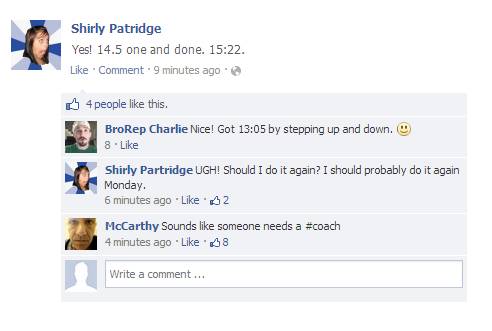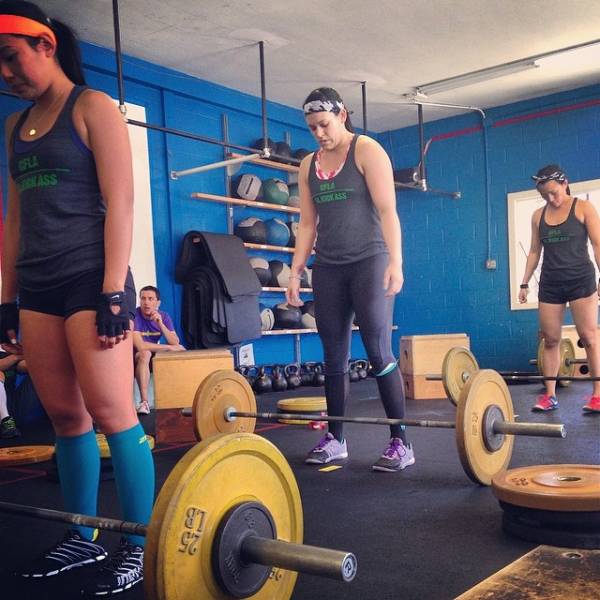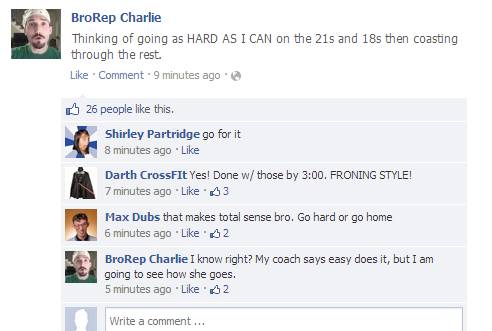Picture this: A CrossFit Games Open workout is announced, and immediately, you take to Facebook and huddle up.
Or how about this scenario:
Picture this: A CrossFit Games Open workout is announced, and immediately, you take to Facebook and huddle up.
Or how about this scenario:

The upside of social media is that we can share thoughts, information, and strategy in a split second with everyone to whom we are connected.
The downside of social media is that we can share thoughts, information, and strategy in a split second with everyone to whom we are connected. (See what I did there?)
Think about it. Every day that you go to your box and embark upon your training, you are most likely seeking counsel from your coach, box owner, or perhaps the firebreather who tends to chew up workouts and always has a solid plan.
For some reason, though, when the workout becomes worldwide, so does our sphere for seeking information, strategy, and advice. I find that curious. Suddenly, the world becomes our coach.
Not that it’s always a bad thing, mind you. In 2013, word of these mysterious “step ups” began circulating via social media hours after the 13.2 was announced, and lo and behold, thousands of us retested the workout and improved our scores – immensely, in fact.
The problem becomes who do you listen to? Everyone is a coach, everyone is a strategist, but frankly, your game is your game. What works for me may not work for you.
If I am a gazelle and you are a buffalo, my gazelle-like “fast on the burpees as though your life depends on it” may crush you before the end of the first round.
So why would you listen to me, unless I am your coach, I know your strengths and weaknesses, and I have helped you strategize up to this point?

Strategy is important, there is no question about that. Going into a workout like 14.5 guns blazing would have resulted in a flameout worthy of a Russian Proton Rocket.
But who do you trust? Within minutes of the conclusion of the Open demo workouts, there were online strategy sessions from everyone ranging from BarBell Shrugged to Outlaw, from OPT to, hell, me.
Listen to enough of those and you’re likely to get directly conflicting information. Outlaw may say unequivocally unbroken on the thrusters, whereas OPT may recommend breaking or, better yet, may recommend breaking based on your ability and your game.
But ultimately, that’s what your coach should be doing. If you don’t have a coach, contact me. If you are a coach and one of your athletes you provide individualized programming and coaching for is bypassing you and turning to Facebook for a game plan, it’s conceivable that there is a rift in your coach-athlete relationship of which you’re not yet aware.
Granted, I get that social media is highly valuable. There can be some real value to the collective amalgamation of chatter that settles into a single voice that rises about the noise.
Information trends, and trends emerge as possible solutions, such as breaking up your deadlifts into sets of five or breaking up your chest-to-bar pull ups.
But before the emergence of the trend, you have nothing but noise. And that noise can be confusing.
And in the context of the CrossFit Open, that noise tends to be the thousands of opinions that bombard you, sometimes mere hours before you’re about to do the workout.
And instead of focusing on your process, you’re focusing on what BroRep Charlie said about using the corner of the box instead of the side.
The bottom line is that the last voice you hear before “3, 2, 1, go,” should be that of your coach. The one who knows your game best.

Photo courtesy of CrossFit LA.






